Using DNA testing with tools: Gworks, DNA2Tree, and Clustering to Solve Unknown Parentage Cases
KITTY MUNSON COOPER
blog.kittycooper.com



Step 1: TEST your DNA:
at Ancestry and 23andme then transfer to the othersUpload the Ancestry DNA results to other sites for free to get more matches:
- MyHeritage*
- Family Tree DNA **
- GEDmatch
- LivingDNA (primarily British, not many matches yet)
**$19 for the full tools
* $29 for the full tools
How does testing your DNA help?
You get half your DNA from each parent, about a quarter from each grandparent and so forth ....so if enough biological relatives are tested you can figure this out

More likely you will need to figure it out from cousin matches
Chart from the ISOGG wiki (courtesy Dimario, Wikimedia Commons)


The "G" trick
The cousin level = the number of "G"s , else the greats plus one
If you are in different generations take the shorter path and the other is removed by the generation difference
If your roots are deeply American, you may only need to test at Ancestry
Any of these matches may resolve the case for you but proceed carefully




Enter the cMs and get probable relationships https://dnapainter.com/tools/sharedcmv4



This online calculator that gives you the probable relationships is an invaluable aid
1878

The DNA Adoption has much help, with a match that close contact is your next step ... review their advice here: https://dnaadoption.org/first-timers/step-9/
Then read step 10: https://dnaadoption.org/first-timers/step-10/
With less close DNA matches, the basic methodology to resolve unknown parentage involves analyzing and building the trees of your best matches ...

Look through the family trees of 2nd, 3rd, and 4th cousin DNA matches for common ancestral couples.




Build private, unsearchable family trees down from each common couple to find where they intersect and produce someone in the right place at the right time.
This may only get to the grandparents or great grandparents
Clustering can be a quick shortcut to finding the common ancestors. The idea is to display your matches who match each other in an easy to understand visual format
You can sign up to cluster at GeneticAffairs.com or you can use the clustering tools from DNAgedcom.com or GEDmatch or MyHeritage or DNA2tree

The result might look like this, each colored box is expected to consist of matches descended from one set of your great grandparents
On some versions of clustering, all the names are clickable to the match (others have a list below)

Here is the cluster image for Jack who was looking for his unknown Dad
The top two boxes were each paternal and the top one was almost all one surname
The clustering methodology was developed by Dana Leeds who has much advice on her site - https://www.danaleeds.com/
This case is mentioned at https://blog.kittycooper.com/2018/12/automatic-clustering-from-genetic-affairs/
There was an unusual surname several times in the 2nd cluster so I used the search box in the large tree for that name and found one couple in recent times where surname 1 married surname 2.
They had 2 sons, one was in the right place at the right time!
A 2nd cousin range match from the first cluster had a huge tree


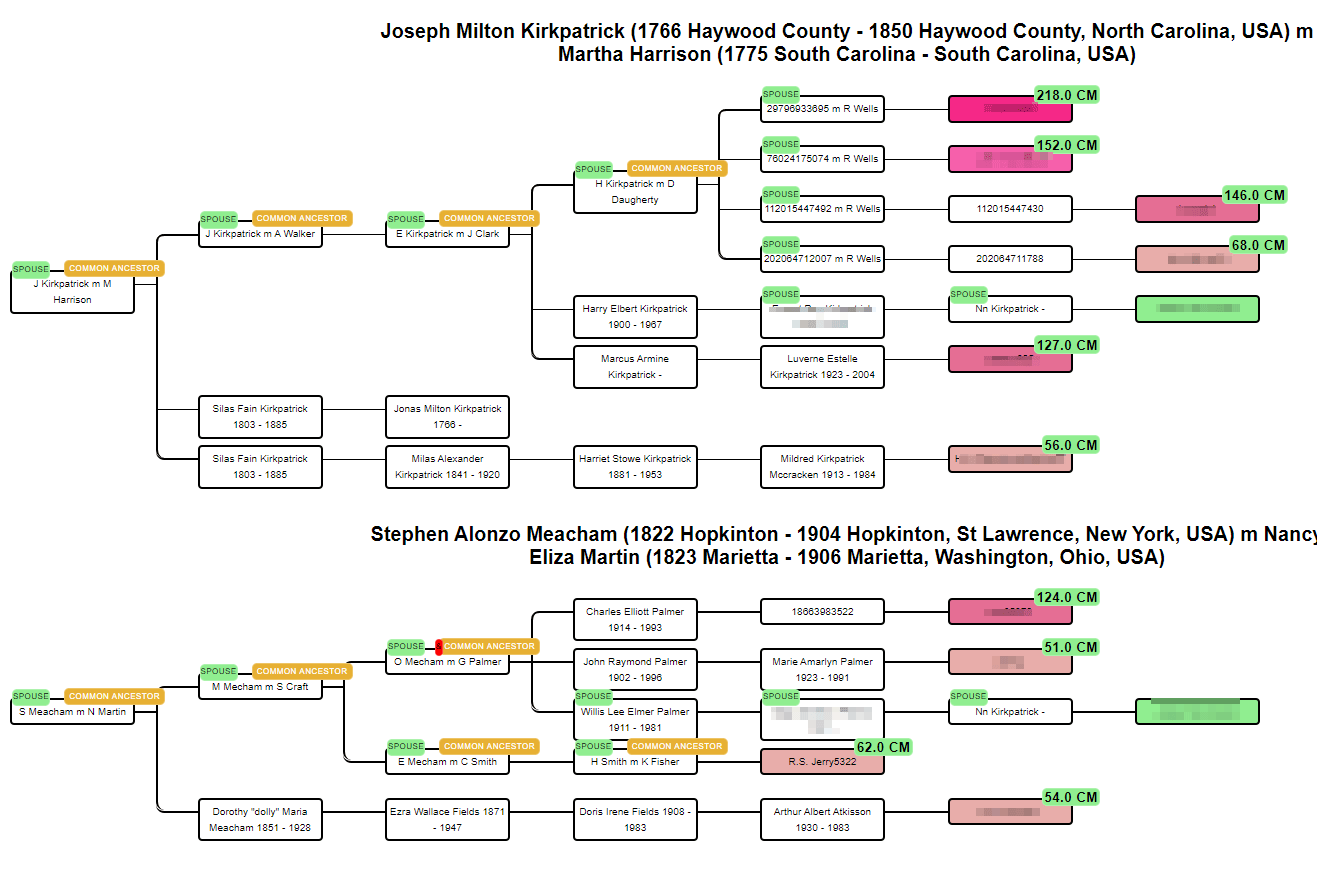
Since that clustered case was resolved, Genetic Affairs has added a tree building feature. These are the trees it made for the top 2 boxes
Jack
Jack
Once you have a candidate parent build their pedigree tree back to at least 1800
Make sure this tree is private and unsearchable initially but once you are ready to try it out, you make it searchable so that ThruLines can use it for you

Add a fake child to that parent and then connect your DNA to that fake person


Ancestry will use auto complete in the name field

Select the pedigree tree you created and link your DNA test to the fake child
Now wait ... it often only takes a day to get common ancestor hints ... see if they are consistent with your hypothesis


Click on each Common ancestor in your match page to view the relationship. Consistent with your theory?
Check the cMs of each match and compare them to the charts
Do they fit your theory?


Is there a faster way to check them?

Using the Genetic Affairs tree building feature might be a faster way to have a look to see if the centimorgan amounts fit

Or you can use the "What Are The Odds" tool at DNApainter to check your theory - https://dnapainter.com/tools/probability

Read this to learn more https://blog.familyhistoryfanatics.com/2019/08/what-are-the-odds-dna.html
Is there automation for comparing trees
to find common ancestral couples?
Or for building trees?

Collects and compares the trees of your matches into your own private database at DNAgedcom.com
DNA2tree
Finds the common ancestors from your Ancestry matches and builds trees!
DNA2tree is only on iPhones and iPads via a paid subscription but it is a real game changer for unknown parentage searches


clicking on Load Some Matches gets these options
Favorites = starred
Next you Find Common Ancestors

Here is a sample set of Common Ancestors
Note the repeating usernames (privatized)

See what happens when you Merge Common Ancestors

Now there are only three lines, with no duplication of user names


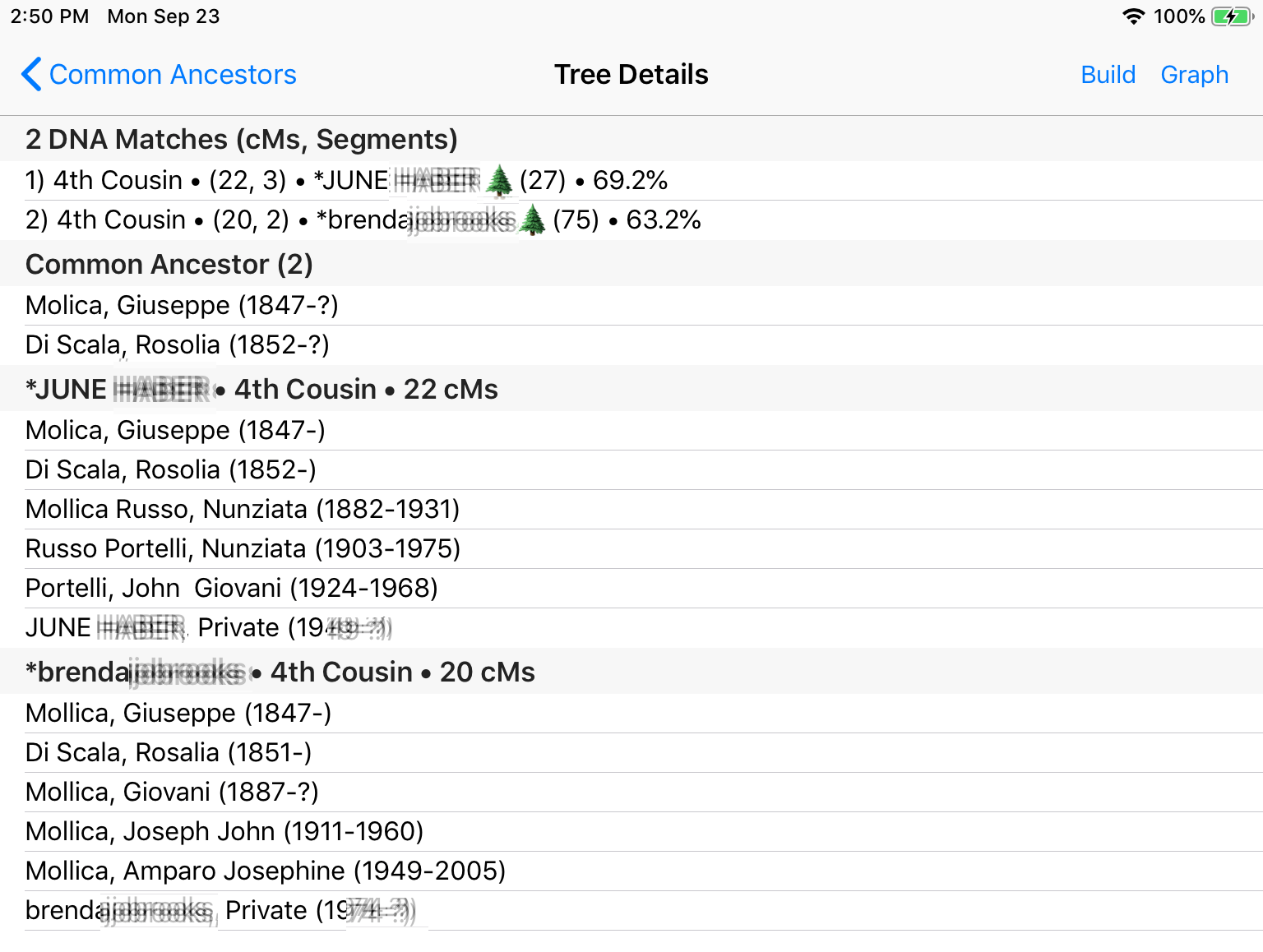

Details of the Molica matches
Click on Graph to see an image
like this
for the
Molica matches
The DNA matches Brenda and June are 3rd cousins

GGGrandparents
GGrand parents

Grand parents

Details of the Mollica matches
Click on Build
DNA2tree asks you what to call the tree and then builds that tree on your account at Ancestry
Molica tree Ancestry built by DNA2tree
For this to work well, you need many matches with good trees


GWORKS is available at DNAgedcom.com
download it by clicking here
Find the app called DNAgedcom Client on your computer or look for this icon
Once you are logged in to your account at DNAgedcom you will see this screen



Enter your ancestry username and password
Once you are logged in, the name(s) of people who have shared DNA with you show up in the profile box, select the desired one in the dropdown

Then choose the cM range, start at 20 for the 4th cousins or better
check the box for gather trees and click Gather DNA Data
WARNING... this gather can take 24 hours, run it overnight!
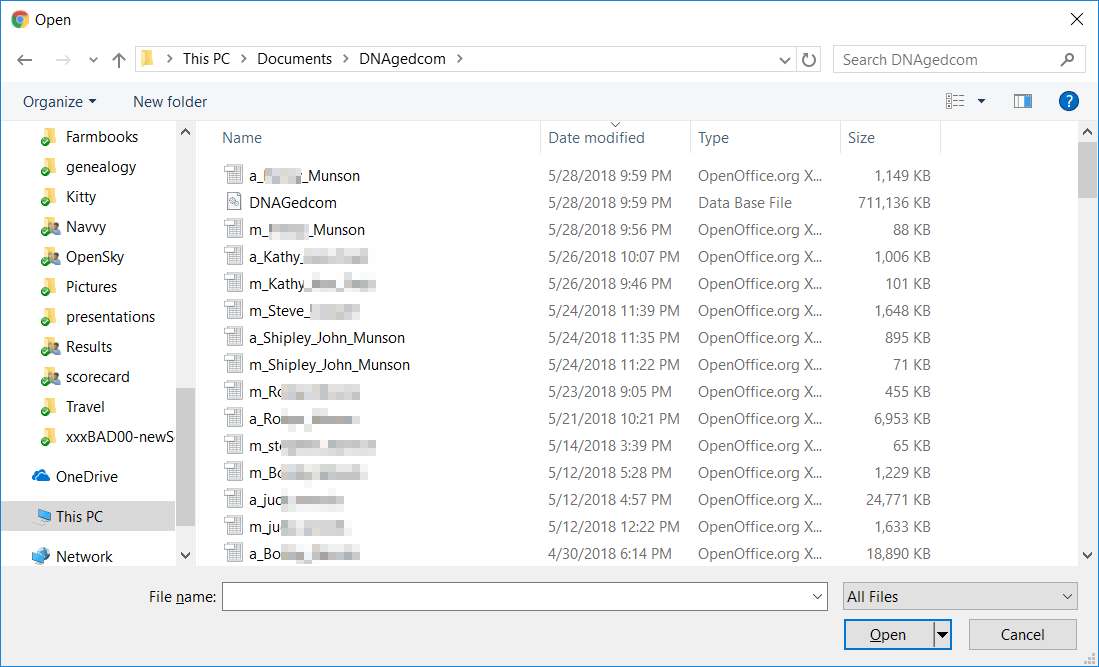
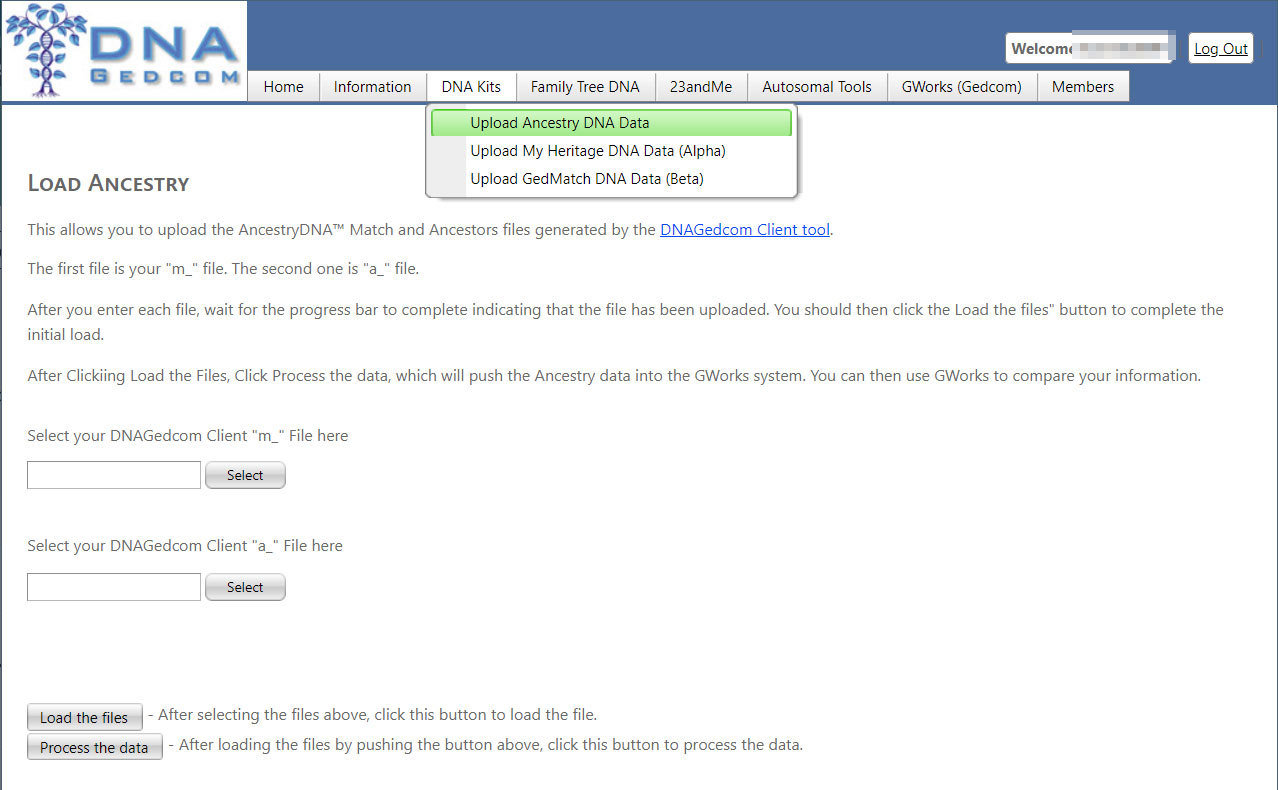


Now your database is ready!
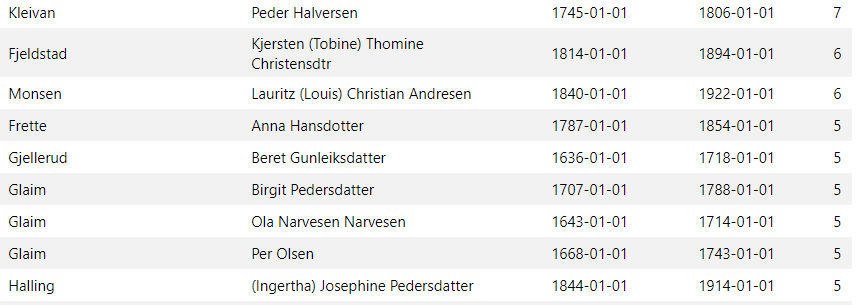


For adoption cases, I usually start by looking for common ancestors born after 1800
by putting 18 in the box at the top of the Birth Date column and clicking StartsWith

Another useful search is to look for a surname, since spelling varies I often start with the first 3 or 4 letters


Click the arrow next to the name so it points down and all the matches who have this person in their tree will show

You can use the "Show Trees " on the Gworks page to delete all but one and then rerun the matching
Jane had a third cousin match at Ancestry with a good tree

Can GWorks can identify which line from the second cousin match is the one they are related on?


Top ten ancestors in GWorks
Can you find any GWorks listed names in the far right of the pedigree?
Three of them have DNA tested descendants, check the abbreviated McGuire diagram for clues

3 children
D


So the next step was to look for the surname of Pratt B's wife and then for child D's spouse


Targeted Testing

Child D's spouse's surname is in the database many times, now to get a child of D, a possible parent to test


Top ancestors for an unknown father case ...
People with endogamous roots do best to wait for close matches, 2nd cousins (or better) ... Tessa had three, one at each site. She also had been told a surname for the father: PADILLA
The 23andme match was the grandchild of (Jose) Pasqual Padilla, sharing 5.1% or 368 cMs.
Based on other matches the 23andme match was confident that he was the half 1st cousin of the Padilla father we were looking for; that Tessa was descended from the 2nd wife of Pasqual,
thus a half first cousin once removed -1C1R


The Ancestry and MyHeritage matches shared common ancestors: surname MARTINEZ
The Ancestry match - 287 cM - had a tree with just parents. Building that tree in our research tree we found the great grandparents of the My Heritage match -282 cM
Eugenio and Maria Martinez

but they were the great great grandparents of the Ancestry match. The son of that couple who was the Ancestry match's grandad had several wives and many children - so perhaps another half 1st1R?


Obituaries are a great source for finding the names and parents of the living. This one from the Albuquerque Journal found the Martinez-Padilla marriage we were looking for
Next task was to see if we could find a daughter of (Jose) Trinidad Martinez married to a son of (Jose) Pasqual Padilla

So did Pasqual have a son named Luis?

Yes Pasqual's son Luis married Teresa Martinez! the daughter of (Jose) Trinidad Martinez
Now which of those 9 sons was in California at the right time?
Only 2 of them
Meanwhile Julie, a daughter of one of the possible half brothers, tested independantly at 23andme and shared 774cM (about 10%)
with Tessa
Now Tessa showed off her sleuthing skills, she called the librarian of the small town that most of these Padillas were from and got copies of their obituaries and lots of information. Neither possible father was still alive but she tracked down a son of each one of them and talked them into testing

So Julie is either a half niece or a 1C1R
image from Blaine Bettinger's chart 2017
Here are the tests results for her possible half brothers



Tessa was welcomed into her father's family; here she is with her half brother and half niece
French Canadian!

Another example of endogamy, recognize this one?
You can use a parent, half sibling or first cousin match to isolate one side by starring those matches in common


The Genetic Affairs clustering tool lets you cluster JUST YOUR STARRED MATCHES
(as does DNA2tree by collecting only those)
DNAgedcom's client, MyHeritage, DNA2tree and GEDmatch all have clustering too


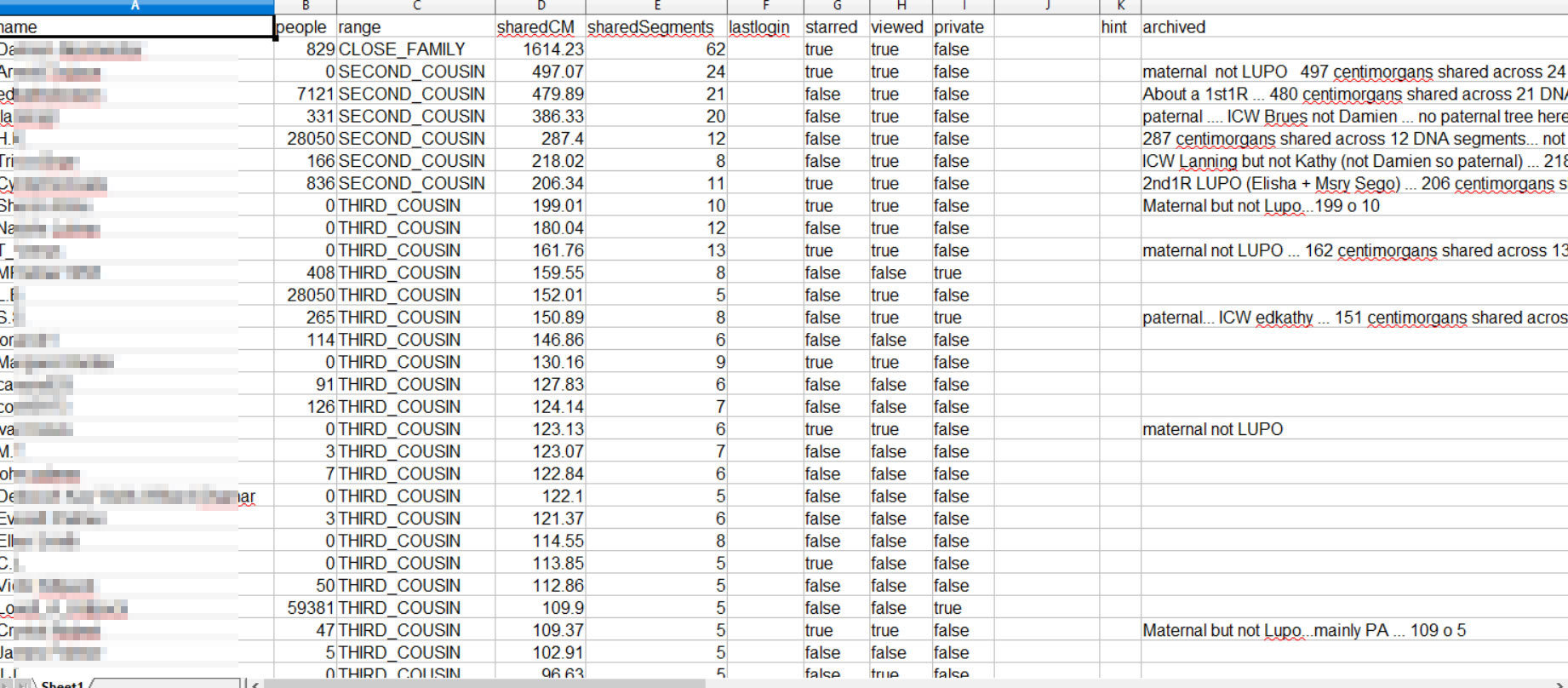
The profile CSV file from Genetic Affairs clustering can be used for tracking your work
But so is the DNAgedcom m_ file a useful spreadsheet for tracking your research



You can upload GEDcoms from other sources and add them to your database at DNAgedcom
be sure to "Match Gedcom files" again after uploading these on the GWorks Manage Tree FIles page

On the View Trees page you can delete any tree by clicking the red X
The source will be blank when it is an uploaded tree
This blog post explains how to make GEDcom files from online trees via various tools https://blog.kittycooper.com/2018/10/collecting-family-trees-with-automation/

To learn more take a class at DNAadoption.com

2. Are there any close matches (1st cousins or closer), figure it out from there
3. Does the genetic affairs clustering and tree builder solve this?
4. If you have DNA2tree, use it to find common ancestors and build a research tree or two
5. Still puzzled? Run GWorks on DNAgedcom and add trees collected elsewhere
6. Once you have some common ancestors, build those trees down to the present looking for someone in the right place at the right time
My CURRENT APPROACH
1. Use the "Are your parents related" (AYPR) tool at GEDmatch on the adoptee

My blog post on using GWorks https://blog.kittycooper.com/2017/09/solving-unknown-parentage-cases-with-dna/
Unknown Parentage Searches - Sept 2019
By Kitty Cooper
Unknown Parentage Searches - Sept 2019
Using GWorks and other tools for adoption searches
- 6,194



